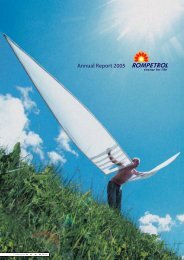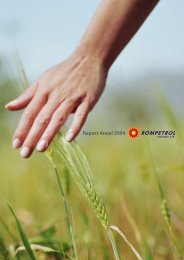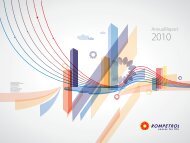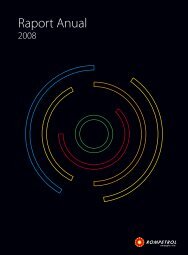You also want an ePaper? Increase the reach of your titles
YUMPU automatically turns print PDFs into web optimized ePapers that Google loves.
Summary of<br />
Significant Accounting Policies<br />
These abbreviated financial statements have been prepared in<br />
accordance with International Financial <strong>Report</strong>ing Standards<br />
(“IFRS”) effective as of December 31, <strong>2009</strong>, as endorsed by the E.U.<br />
The consolidated financial statements are prepared under the<br />
historical cost convention except for <strong>Rompetrol</strong> Rafinare S.A and<br />
<strong>Rompetrol</strong> Petrochemicals S.R.L where the property, plant and<br />
equipment are stated at revalued amounts being the fair value,<br />
less any accumulated depreciation and accumulated impairment<br />
loss. The financial statements of the Group are prepared on a<br />
going concern basis.<br />
The group’s consolidated financial statements are presented in<br />
United States Dollar (“US Dollar” or “USD”), which is the Group’s<br />
functional currency.<br />
The consolidated financial statements <strong>com</strong>prise the financial<br />
statements of the parent <strong>com</strong>pany and its subsidiaries as of<br />
December 31, <strong>2009</strong>.<br />
Control is considered to be achieved where the Group (either<br />
directly or indirectly), owns more than 50% of the voting rights of<br />
the share capital of another enterprise and is able to govern the<br />
financial and operating policies of an enterprise so as to obtain<br />
benefits from its activities. Minority interests represent the portion<br />
of the profit or loss and net assets that is not held by the Group and<br />
are presented separately in the consolidated in<strong>com</strong>e statement<br />
and within equity in the consolidated balance sheet, separately<br />
from the parent shareholders’ equity.<br />
Acquisitions of businesses are accounted for using the purchase<br />
method. The cost of the business <strong>com</strong>bination is measured as the<br />
aggregate of the fair values (at the date of exchange) of assets<br />
acquired, liabilities incurred or assumed, and equity instruments<br />
issued by the Group in exchange for control of the acquiree, plus<br />
any costs directly attributable to the business <strong>com</strong>bination.<br />
The interest of minority shareholders in the acquiree is initially<br />
measured at the minority’s proportion of the net fair value of the<br />
assets, liabilities and contingent liabilities recognized. Businesses<br />
acquired or disposed during the year are included in the<br />
consolidated financial statements from the date of acquisition or<br />
the date of disposal.<br />
The Group’s investments in associates are accounted for using<br />
the equity method of accounting. Under the equity method, the<br />
investment in an associate is carried in the balance sheet at cost<br />
plus post acquisition changes in the Group’s share of net assets of<br />
the associate. After application of the equity method, the Group<br />
determines whether it is necessary to recognise an additional<br />
impairment loss on the Group’s investment in its associates.<br />
All intra-group balances, in<strong>com</strong>e and expenses and unrealised<br />
gains and losses resulting from intra-group transactions are<br />
eliminated in full.<br />
Goodwill is initially measured at cost being the excess of the cost<br />
of the business <strong>com</strong>bination over the Group’s share in the net fair<br />
value of the acquiree’s identifiable assets, liabilities and contingent<br />
liabilities. Goodwill is tested for impairment annually (as at 31<br />
December) and when circumstances indicate that the carrying<br />
value may be impaired.<br />
Property, plant and equipment are stated at cost, except for the<br />
<strong>Rompetrol</strong> Rafinare S.A and <strong>Rompetrol</strong> Petrochemicals S.R.L,<br />
where the property, plant and equipment are stated at re-valued<br />
amounts, being the fair value less any accumulated depreciation<br />
and accumulated impairment loss.<br />
When assets are sold or retired, their cost and accumulated<br />
depreciation are eliminated from the accounts and any gain or loss<br />
resulting from their disposal is included in the in<strong>com</strong>e statement.<br />
Depreciation for property, plant and equipment except land<br />
and construction in progress is <strong>com</strong>puted using the straight-line<br />
method over the following estimated useful lives, between 3 to 60<br />
years.<br />
At each balance sheet date the Group reviews the carrying<br />
amounts of its property, plant and equipment and intangible<br />
assets to determine whether there is any indication that those<br />
assets have suffered impairment. If such indication exists, the<br />
recoverable amount of the asset is estimated in order to determine<br />
the extent of the impairment loss (if any). Where it is not possible<br />
to estimate the recoverable amount of an individual asset, the<br />
Group estimates the recoverable amount of the cash-generating<br />
unit to which the asset belongs.<br />
Inventories, including work-in-process are stated at the lower<br />
of cost and net realisable value. Net realisable value is the<br />
selling price in the ordinary course of business, less the costs of<br />
<strong>com</strong>pletion, marketing and distribution. Cost <strong>com</strong>prises direct<br />
materials and, where applicable, direct labour costs and those<br />
overheads that have been incurred in bringing the inventories to<br />
their present location and condition. The following cost formulas<br />
were used to determine the cost applicable to different types of<br />
inventories:<br />
• the weighted average method for purchased crude oil and<br />
petroleum products;<br />
• the first-in-first-out (FIFO) for supplies and materials.<br />
Trade receivables are recognised initially at fair value and<br />
subsequently measured at amortised cost using the effective<br />
interest method, less provision for impairment.<br />
Cash includes cash on hand, cash with banks and checks in course<br />
of being cashed. Cash equivalents are short-term, highly liquid<br />
investments that are readily convertible to known amounts of cash<br />
within remaining three months or less to maturity from the date of<br />
acquisition and that are subject to an insignificant risk of change<br />
in value.<br />
Revenue is recognised to the extent that it is probable that the<br />
economic benefits will flow to the Group and the revenue can be<br />
reliably measured.<br />
Sales of goods are recognised when delivery has taken place and<br />
transfer of significant risks and rewards has been <strong>com</strong>pleted.<br />
Revenue <strong>com</strong>prises the fair value of the sale of goods and services,<br />
net of value-added tax and any excise duties and other sales taxes,<br />
rebates and discounts.<br />
<strong>2009</strong> <strong>Annual</strong> <strong>Report</strong> 68




![Scrisoarea Directorului General de Opera]iuni - Rompetrol.com](https://img.yumpu.com/4907398/1/184x260/scrisoarea-directorului-general-de-operaiuni-rompetrolcom.jpg?quality=85)







